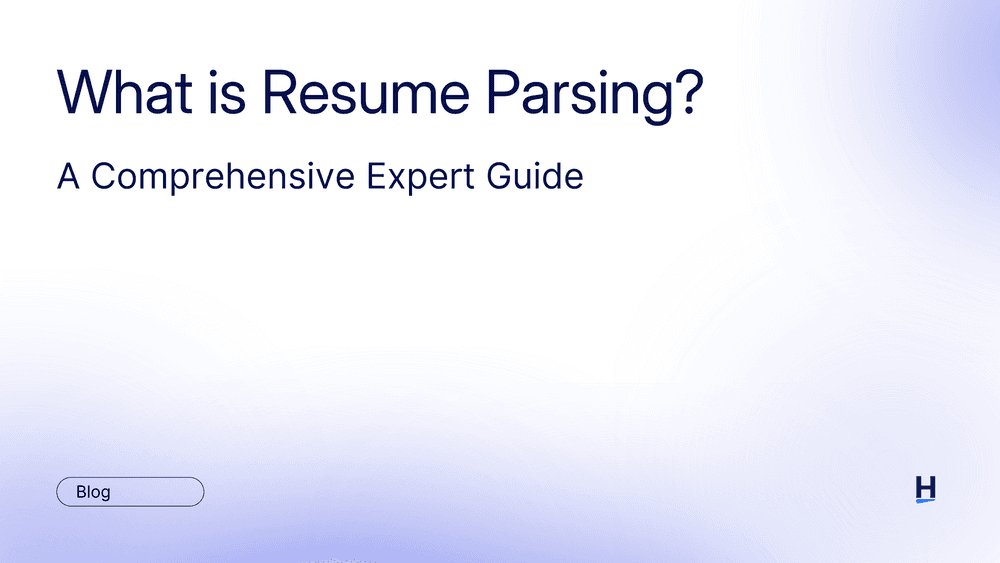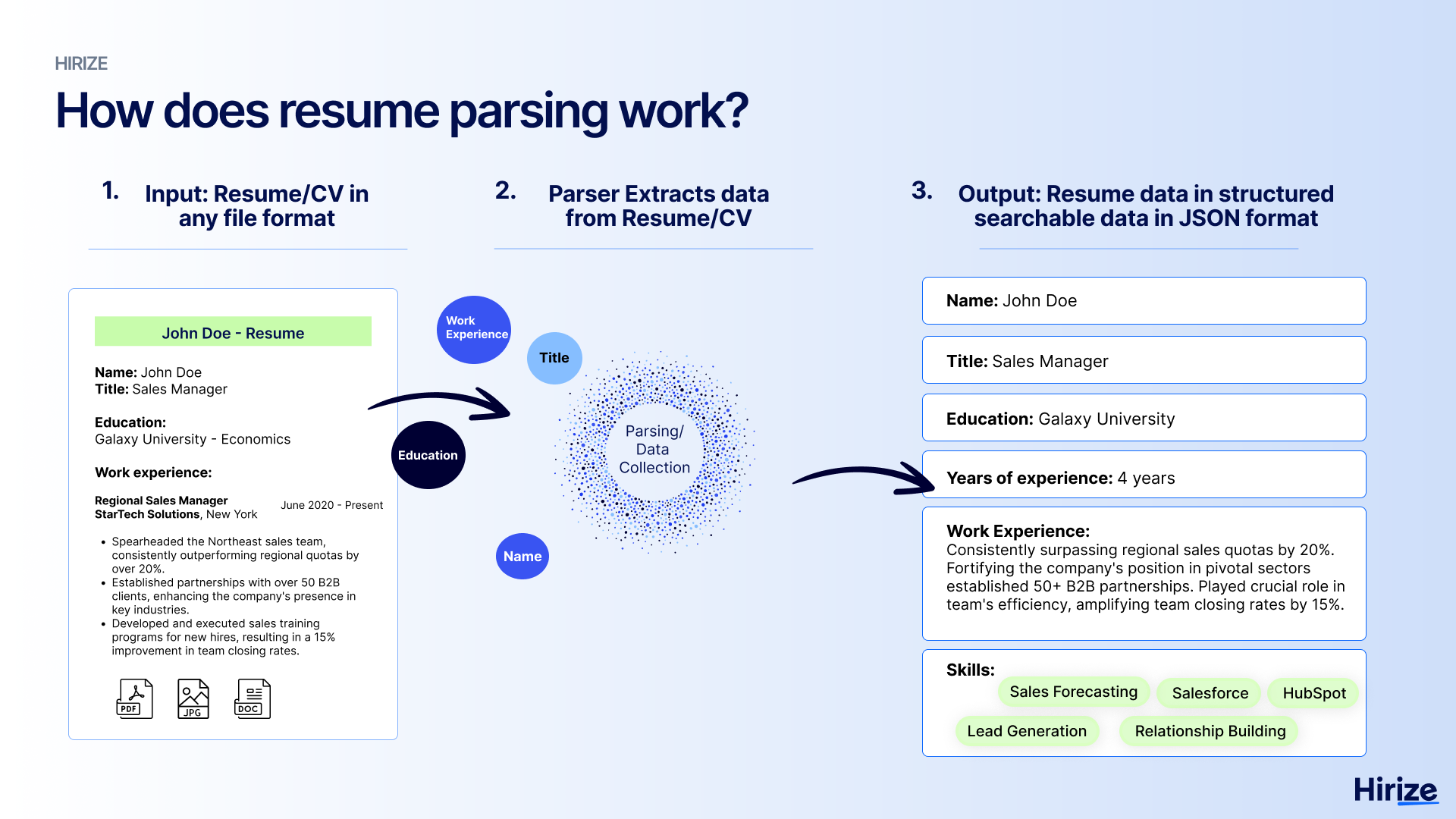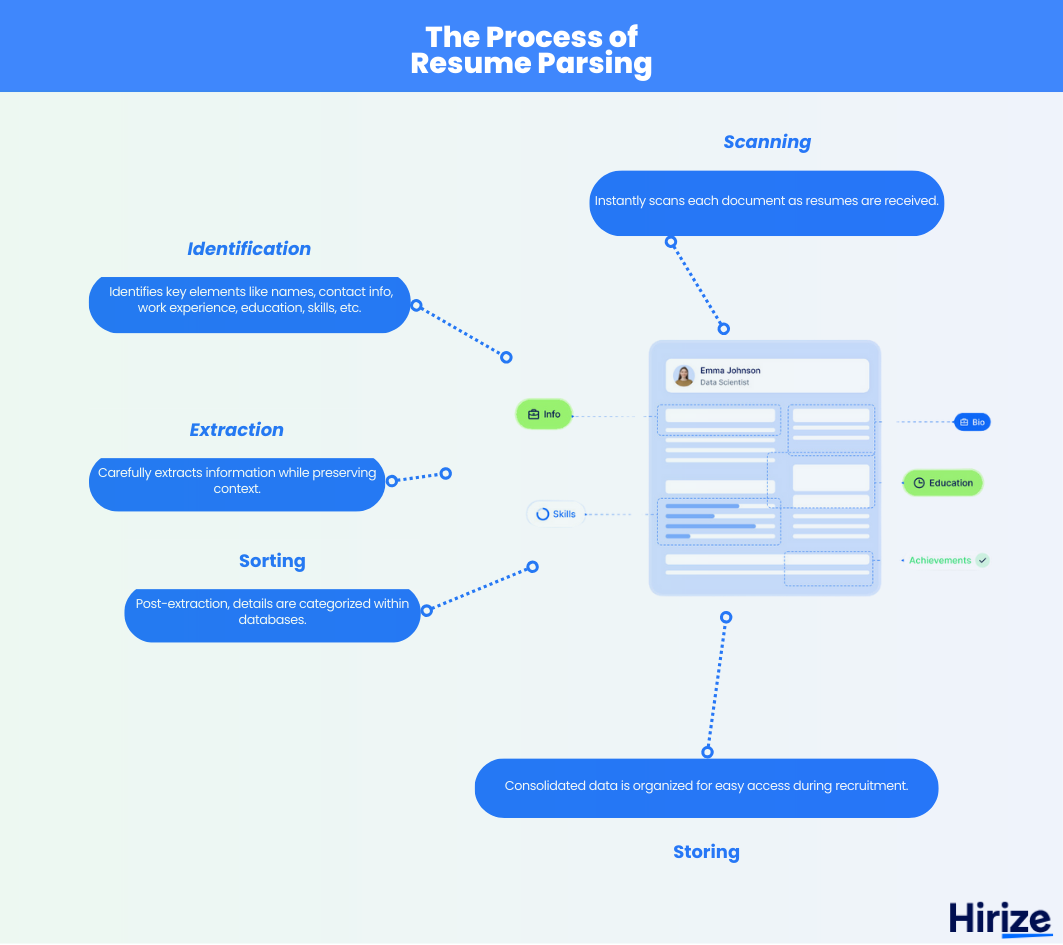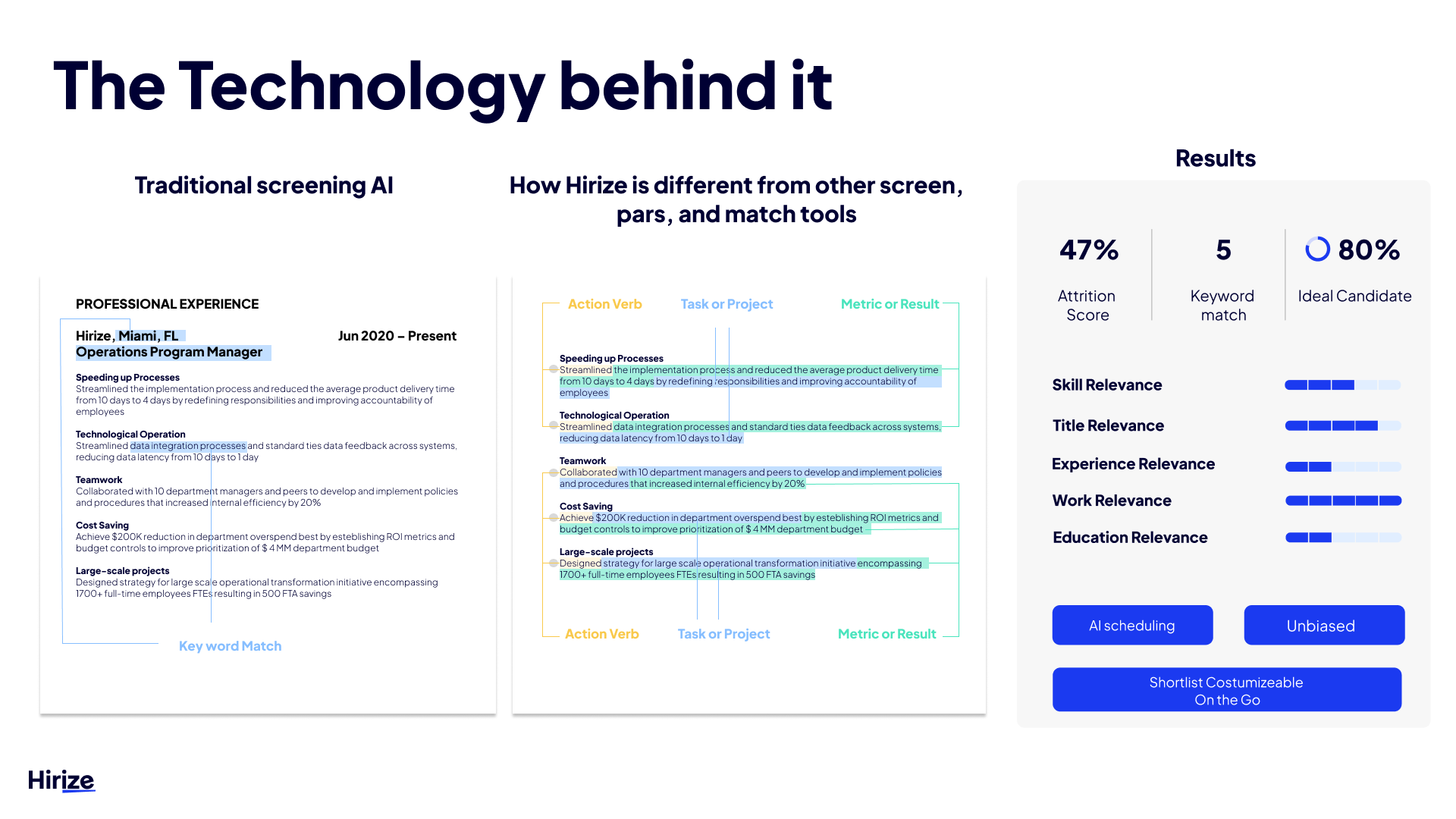superpowers?
What is Resume Parsing? Definition, Benefits, Use Cases, Mechanism, Challenges
Understand resume parsing and its role in modern HR tech. Enhance your recruitment with our tips on leveraging parsing.

In today’s fast-paced recruitment landscape, the efficiency and accuracy of candidate evaluation are paramount. This is where resume parsing plays a pivotal role.
In this blog post:
- Definition of resume parsing
- How to define what a good parser is?
- The benefits of resume parsing
- How to select a resume parser?
- Resume parser use cases
- How does resume parsing work?
- Challenges of resume parsing
Definition of resume parsing
Resume parsing, also known as CV parsing, is an API-based software solution designed to extract essential information from resumes for storage in a database. This facilitates efficient candidate-job matching and streamlines resume retrieval in databases such as job boards.
The effectiveness of this technology hinges on the sophistication of the underlying AI tools. More advanced technologies, characterized by higher accuracy in data extraction, lead to better system functionality, more accurate matches, and enhanced search capabilities.
You can see a resume parser as an AI-driven automated process that involves extracting and converting unstructured data from resumes - including contact information, educational qualifications, professional experience, technical skills, certifications, and more - into a structured and standardized format.
Utilizing advanced algorithms, typically based on Optical Character Recognition (OCR) and Natural Language Processing (NLP), this technology interprets complex data accurately. It then populates predefined fields, outputting the information in formats like JSON or XML. This transformation results in detailed, easily analyzable candidate profiles.
- A resume gets uploaded to the parser
- The parser finds all the information and classifies it.
- Next, it takes all information and creates a structured data model, often called a 'parse tree' this is the process where the right information is put in the right box.

How to define what a good parser is?
Defining a good parser hinges on its technological sophistication and the functionalities it offers. Key features vary across different AI models:
Rule-Based Parsers (low accuracy):
- Ideal for parsing text-based files like Word documents.
- Efficient for straightforward data extraction.
Machine Learning-Based Parsers (peaks at 80% accuracy):
- Advanced to handle a wider range of file formats, including PDFs and Word documents.
- Integrated technologies like OCR enable them to parse image-based resumes and documents, overcoming the limitation of text-only parsing.
- These parsers learn and adapt over time, but may struggle with highly stylized or complex layouts.
The latest upgrade in parsers are Deep Learning & LLM-based parsers (up to 95% accuracy):
- Represent the cutting edge, utilizing Large Language Models and deep learning.
- Adapt and improve over time for higher accuracy.
- Capable of parsing and understanding data in multiple languages and various formats.
- Excel in contextual and nuanced data interpretation, significantly improving accuracy and effectiveness.
Each generation of parsers has built upon the last, moving from rule-based text extraction to sophisticated, AI-driven understanding and processing of a wide array of document types and languages. This evolution underscores the increasing capability of parsers to handle complex and varied data with higher precision/accuracy. Hirize's resume parsing software utilizes latest technologies such as Deep Learning & LLMs. You can try Hirize's AI-driven resume parser for free now!
The Benefits of Resume Parsers
In environments where large volumes of resumes are being received such as at large enterprises, recruitment agencies and HR vendors, resume parsers come into play. They can handle large volumes of resumes with accuracy. This accuracy is important for the later stages when candidates get matched against jobs or searches in resume databases:
Efficiency and time-saving benefits
Imagine being able to scan hundreds of resumes within seconds while accurately extracting key credentials relevant to a job posting. This is precisely what resume parsing facilitates. This technology parses text from resumes by leveraging sophisticated algorithms, transforming unstructured data into organized information. Such efficiency not only alleviates the workload on hiring managers but also expedites the initial screening phase significantly:,
For recruiters:
- You save time that would otherwise be spent reading through each submission manually.
- Fast-tracking viable candidates becomes straightforward as you swiftly identify those who meet specific criteria.
- Streamlines your workflow, allowing you to focus on other critical aspects of recruitment, such as interviews and interactions with potential hires.
HR Vendors:
- Optimize business processes for clients
- Offer solutions that shorten business processes
- Add benefit by automating manual tasks
- Offer greater accuracy (no user likes to see that some great applicants were missed due to inaccurate parsing of the profile)
A database pre-populated with candidate information allows for quick searches and comparisons, leading to an accelerated hiring process that benefits both employers and job seekers alike.
Ability to handle large volumes of resumes
In today's job market, single job postings can elicit a deluge of applications, becoming overwhelming in no time at all. Resume parsing is particularly valuable because it boasts the capacity to:
- Parse multiple resumes simultaneously — handling volume without sacrificing attention to detail.
- Maintain resume data in an easily accessible format for future reference.
- Assist larger organizations or popular industries where application influx is consistently high.
By deploying a system equipped with resume parsing capabilities, businesses remain agile even when faced with torrents of potential candidates.
Increased accuracy in identifying relevant information
At the intersection between language nuance and technological precision lies one of the most compelling advantages that resume parsers offer: increased accuracy. It outperforms manual methods by eliminating human error, such as overlooking key qualifications or valuable experiences due to fatigue or distraction. Consider these points about how accuracy is enhanced:
- Resume parsers are programmed to recognize pertinent information, adhering closely to predefined parameters.
- They apply robust filters and ranking systems to prioritize candidates whose qualifications align perfectly with job requirements.
- With learning capabilities infused into some of these systems, they adapt over time, refining their search patterns to yield ever more precise results.
Increased diversity and inclusion in hiring practices
An interesting yet profound benefit of using sophisticated technologies such as Hirize's AI-driven tools lies within its potential to support diversity and inclusion efforts:
- Reduction of Unconscious Bias: The automation process minimizes human prejudices that may inadvertently affect candidate selection.
- Expansive Talent Searches: With the ability to efficiently parse through diverse databases across various platforms, organizations are better equipped to reach underrepresented groups.
- Comprehensive Reporting: Analytical insights help companies understand demographic trends within their applicant pool and adjust strategies accordingly.
How to select a resume parser?
Selecting the right parser for the function you need is important. Here are some of the important point to look at:
- Capable of parsing resumes in various formats such as PDF, Word (doc, docx), HTML, and jpg.
- Effortless integration with your current software systems.
- Multilingual resume/CV parsing capability, automatically recognizing different regions and languages.
- Promotes unbiased hiring processes.
- Advanced parsing technology to meticulously extract information from over 100 distinct data fields in resumes.
- Utilizes sophisticated deep learning algorithms to enhance data extraction and refine resume information identification, leading to superior search outcomes.
- Bulk import feature enables simultaneous parsing of multiple resumes/jobs.
- Delivers parsed data in a standardized document template, ensuring consistency in data presentation. (think XML, Json)
For more information on this topic, check out our guide on choosing a resume parser.
Resume parser use cases
Resume parsers, powered by AI, significantly streamline the hiring process across various sectors in the HR industry. From ATS providers to educational institutions, the applications of resume parsers are as diverse as they are impactful. Let’s explore how different user groups leverage these tools to enhance their recruitment and talent management processes.
HR Vendors (ATS Providers):
Use Case: Integrating parsing and matching APIs to translate resumes into structured applicant profiles.
Example: Automating the screening process by ranking candidates based on job requirements.
Recruiting Agencies:
Use Case: Collecting applications and converting them into standardized profiles for presentation to clients.
Example: Creating detailed candidate portfolios to showcase to potential employers, highlighting key skills and experiences relevant to specific job openings.
Job Boards:
Use Case: Utilizing parsers to categorize and tag resumes, enhancing job matching accuracy.
Example: Automatically filtering and suggesting job listings to candidates based on their resume content; helping employers find candidates with specific skill sets more efficiently.
Large Enterprises (HR Departments):
Use Case: Implementing parsers for internal talent acquisition and workforce planning.
Example: Identifying internal candidates for promotion or new roles based on skills analysis; analyzing workforce skills to identify training needs or hiring gaps.
Educational Institutions (Career Services):
Use Case: Assisting students in aligning their resumes with internship and job opportunities.
Example: Analyzing student resumes to suggest relevant extracurricular activities, internships, or entry-level jobs that match their skills and academic background.
Freelance Recruiters:
Use Case: Using parsers to efficiently manage a diverse range of client requirements and candidate profiles.
Example: Quickly shortlisting candidates from a large pool for various client vacancies, ensuring a good match between job requirements and candidate skills.
As we’ve seen, resume parsers are not just tools but strategic enablers in the realm of human resources. Whether it’s simplifying candidate screening for a large enterprise, aiding a job board in providing targeted job matches, or helping a university guide students toward their career goals, the applications of resume parsing technology are vast and varied. By automating the extraction and analysis of key data from resumes, these tools are reshaping the way organizations approach talent acquisition, internal mobility, and workforce development, paving the way for a more efficient, data-driven HR landscape.
How Does Resume Parsing Work?
Resume parsers scan resumes and then identify, extract, sort, and store necessary data.
The Process of Resume Parsing
Here's how the process works:

1. Scanning: As resumes roll in, the algorithm instantly scans each document.
2. Identification: It identifies essential elements such as names, contact information, work experience, education history, skills, etc.
3. Extraction: This information is then carefully extracted without displacing context—a key factor for the next phases.
4. Sorting: After extraction, it comes to the cataloging stage, where details are sorted into relevant categories within databases.
5. Storing: Finally, the consolidated data lands are safely organized for easy access during recruitment processes.
Natural Language Processing Techniques Used in Parsing
Some resume parsers extensively use Natural Language Processing (NLP)—a branch of AI that enables machines to understand and interpret human language.
- OCR Technology: At its core lies Optical Character Recognition (OCR), which converts different types of documents containing written text into machine-encoded text.
- Syntax Analysis: The system employs syntax analysis techniques recognizing patterns and grammatical structure to determine if words are nouns (like company names) or dates (for employment periods).
- Semantic Analysis: Beyond grammar, semantic processing discerns meanings from sentences—That is to say, it recognizes 'manager' as an employment designation rather than just any word.
- Contextual Parsing: Potent algorithms decode contextual cues. For instance, it ensures that Jane’s Java programming experience doesn’t get mixed up with her coffee barista stint.
Hirize integrates GPT alongside NLP for unparalleled understanding and predictive analysis capabilities. As a result, its accuracy rate is 95%, being higher than the industry average.
Challenges of Resume Parsing
As with any technological advancement, resume parsing is not devoid of its challenges. While it greatly streamlines the recruitment process, there are several concerns
Limitations of Keyword-Based Parsing
Keyword-based parsing was once the backbone of resume filtering. However, this method comes with significant pitfalls:

-
Keyword tunnel vision: Sole reliance on keywords can lead to myopic results where outstanding candidates are overlooked because their resumes don't contain specific terms an employer has predetermined.
-
Context neglect: When a parser depends only on keywords, it often misses the context surrounding those words which could indicate a candidate's actual competency and experience better.
Companies like Hirize have recognized these issues and utilize AI technologies such as natural language processing (NLP), which transcend simplistic keyword matching.
Handling Variations in Resume Formats and Structures
Another pressing challenge is managing the disparities in how resumes are structured:
- Diverse presentation styles: Candidates present their backgrounds uniquely—some prefer chronological listings while others opt for functional or combined formats.
- Non-standardized headings: Varying terminology used for sections such as work experience (e.g., “Professional Background," "Career Synopsis,” etc.) can confuse parsers that aren’t programmed to recognize synonyms.
Hirize’s AI-powered resume parser addresses this impediment head-on by utilizing OCR and GPT models adept at interpreting various document layouts and terminologies, thereby ensuring a wider range of resumes is accurately read and evaluated.
Dealing with Ambiguous or Incomplete Information
One more obstacle worth noting involves parsing anomalies like ambiguity or gaps:
-
Ambiguity: Not all professional experiences are black-and-white. There might be overlapping roles or vague job descriptions that don’t translate well into algorithms’ binary understanding.
-
Incomplete information: At times, applicants may submit resumes lacking key details either inadvertently or due to privacy concerns, leading parsers astray.
Hirize rises above these difficulties by designing its system with a failsafe capable of flagging imprecision and learning during processes to improve accuracy over time. Its advanced analytics also play a pivotal role in discerning patterns that suggest unspoken qualifications beyond what's plainly stated on paper. Try Hirize's advanced resume-parsing software today!
superpowers?



